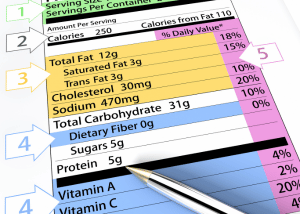
When you choose a food at the grocery store, do you roll your eyes, toss it in your cart, and ignore the label? Or, do you read, digest, and try to understand it?
For most of us, understanding food labels is a lifelong effort. Not only has the look of food labels changed over the years, but their information hasn’t always been standard from product to product. Today’s labels include the List of Ingredients and the Nutrition Facts Label and both can be very useful in guiding us to healthier foods. The Food and Drug Administration (FDA) of the US government updated and standardized the information on Nutrition Facts Labels in 2016 and by 2020-21 most manufacturers’ labels changed. This was very positive because, as consumers, we can now accurately compare the labels of 2 boxes or 2 brands of the same food product and make an informed choice.
5 Common Mistakes Made when Reading Food and Nutrition Labels
Because there is so much information printed on food and nutrition labels and education isn’t easy to find, many people feel overwhelmed at the grocery store. Other people use the labels a bit, typically reading for one specific nutrient or a couple of nutrients. Unfortunately, misunderstandings are common. Here are 5 mistakes to avoid when reading food and nutrition labels so that you unpack your groceries at home knowing more about their nutritional features.
- Read the front-of-package claims and fail to fact check by also reading the Nutrition Facts label on the back of the package. The wording on the front of a food package can lure us into choosing it. The words used by food manufacturers grab our attention and increase the odds of a sale for them. For example, no cholesterol; sugar free; trans fat free; and multigrain. These words entice us even when we’re not entirely sure what they mean. Advice: Always turn over the package and read over the Nutrition Facts, and then make an informed decision to buy it or not.
- Fail to read the servings per container. The servings per container are listed at the very top of the Nutrition Facts label. This information goes hand in hand with the serving size and both are designed to help us buy the right amount of food. For example, a standard 15.5 ounce can of black beans will serve 3 people a side for dinner. The same can will yield 1-3/4 cups of beans for a recipe. Advice: Think about how much you need of a specific food, using servings per container, as a way to manage your kitchen inventory.
- Look only at the calories. The calories per serving can be a source of too much focus for some people. If your serving is the same as what’s listed on the Nutrition Facts label then you will have a good estimate of your calorie intake. Do remember that not all calories are the same and getting higher quality, nutrition-packed calories is the goal. Advice: Glance at the entire Nutrition Facts label along with reading calories per serving so that you feel more confident with your choice.
- Overlook or misunderstand the amount of sodium and/or added sugars. The Nutrition Facts label has fine details for some nutrients, like sodium and added sugars. For healthy people, 400-500 milligrams of sodium is reasonable for one meal. And, 100 milligrams of sodium is reasonable for one snack. When reading the label for grams of added sugars, less is best. Advice: Focus food choices on sugars/carbs that come from a natural source like fruit, whole grains, starchy beans and other starchy vegetables. Also, compare similar foods’ labels and choose fewer grams of added sugars.
- Forget to read the Ingredient List. The ingredient list for a food product is very important. Many high quality foods have one single ingredient. For example, frozen strawberries; dried raisins; oats; and unsalted almonds. Many others have few ingredients. For example, milk; canned salmon; and frozen peas. The food products with longer ingredient lists can contain problematic ingredients. For example, MSG; yellow dye #2; sodium benzoate; and EDTA. While these additives are used in tiny amounts that the FDA deems safe, some individuals can be sensitive. Advice: It only takes a few minutes to read the ingredient list so always take time to do this.
5 More Common Mistakes Made at the Grocery Store
Here are 5 more mistakes to avoid as you make a habit of healthier, more mindful grocery trips.
- Decide to go to the grocery store while in a big hurry and forget to plan ahead.
- Grab a cart at the door of the store and fail to wipe it down with sanitizing wipes.
- Talk on your cell phone or daydream while choosing groceries.
- Get tempted by a 2 for 1 sale and buy something you don’t need.
- Forget to review your cart just before checkout and end up spending too much.
How to Overcome Grocery Store Mistakes and Learn Healthier Habits
There are thousands of food products in the average grocery store so feeling overwhelmed is normal. When you get organized and plan ahead for your upcoming meals and shopping trip, there’s a lot less stress. This earlier blog called, The Hardest Part of Grocery Shopping Nutritionally Speaking, walks you through the process. This free resource called, 6 Quick Mediterranean Grocery Tips takes you aisle-by-aisle to discover healthier food choices.
To fast track your learning, consider taking a customized, hands-on lesson in smart grocery shopping and label reading. Click here for the details and scroll down to Grocery Store Tours.